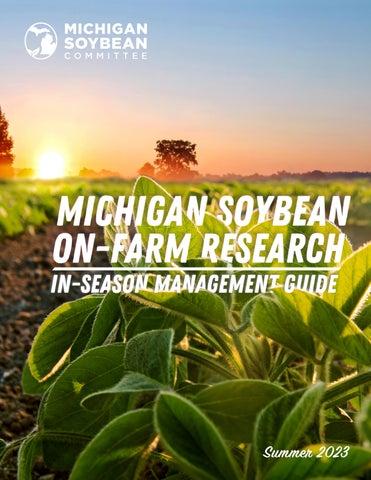Michigan Soybean Research Trials 2025: The MSU Approach to Innovation
Researchers, extension specialists, and everyday producers across Michigan are gearing up for the next season of on-farm soybean research trials. Each year, priorities shift—what held farmers’ attention last spring may be supplanted by a new emerging pest or abrupt rainfall pattern; that’s the rhythm of agriculture in Michigan.
The partnership between Michigan State University Extension and the Michigan soybean Committee persists into its 16th consecutive year. Their commitment is extraordinary: take real concerns raised by growers themselves—gleaned from winter meetings where anxieties about everything from planting depth to foliar disease control crop up—and translate those into practical field experiments targeting measurable yield or profitability gains. In 2024, dozens of trial plots stretched from Lenawee County north to Saginaw Valley. More than fifty volunteer farmers operated across an unusual sixty-one fields—not a small feat by any measure. Trial designs intentionally avoid running parallel to existing tiling lines so water percolation remains uniform within every replicate block.
A handful of studies command special interest heading into 2025. Seeding rate calibrations will again be under scrutiny—a perennial question with no universally applicable answer because hybrid genetics and microclimates differ immensely even over short distances. Strip trial plots requiring four replicates minimum are allotted products with somewhat limited inventory (first-come, first-served). Results aren’t only given back as raw figures but distilled annually in detailed reports distributed to more than ten thousand growers statewide—numbers suggesting broad confidence among stakeholders that these data matter.
Some research focuses on innovative insecticide submission timings during R1–R3 stages; others probe variable-rate planting dictated by real-time sensor readings mounted directly onto planters rolling through loamier bottomland one moment, sandy outwash soils the next moment unpredictably changing conditions once more—there’s always another anomaly awaiting investigation under actual production circumstances rather than greenhouse glass.
Meeting schedules posted for early January already show a busy slate: St. Johns on january ninth; Lenawee Christian Center in Adrian not long before; evenings planned for Kingston and Zeeland after that if you can make it (if not there are summary handouts). Pesticide applicators will reap recertification credits if they sit through results presentations—a minor incentive perhaps but one appreciated quietly all the same.
It’s notable how feedback loops operate within this system: insights gained at past update meetings inform future experimental design choices but sometimes findings force researchers right back to their initial assumptions for reevaluation when results confound expectations entirely (no one expected inoculant trials on glossy green beans would double stand counts near Frankenmuth last year). Sometimes this cyclical process feels circular instead of progressive yet agronomy rewards skepticism as much as tradition despite what experts might imply otherwise.
Weather patterns lately haven’t been cooperating uniformly either—not unusual here but still infuriating at times when downpours cut plot access short or cracks snap open in midsummer clays after weeks without precipitation—but steadfast volunteers truck ahead adjusting logistics ad hoc as needed because no statistical model captures every exception nature throws their way even though universities try meticulously each season nevertheless some say outcomes aren’t easily replicable anyway which paradoxically increases trust among producers who want solutions under local conditions not hypothetical averages derived elsewhere far away across different temporalities altogether.
Perusing through past management guides reveals incremental progressions alongside persistent dilemmas unyielding no matter how many tables crammed full with odds ratios or means comparisons line each annual report—from seed treatment efficacy comparisons using neonicotinoid chemistries unavailable previously due to regulatory constraints upturning established knowledge mid-study occasionally—to soil compaction analysis via penetrometer readings repeated until fatigue sets in late afternoons while sun glints off top sheets swaying tall against windbreak rows nearby soy intercropped grasses barely registering improvement statistically speaking unless data adjusted again appropriately so conclusions reflect field-scale relevance above all else or at least come close enough most years except when measurements contradict anticipated trends unexpectedly anyhow few mention those sessions afterward unless asked specifically during winter meeting breakout groups tending toward good-humored debate interspersed amongst coffee refills abounding regardless outcome consistency is variable just like row spacing preferences remain stubbornly individualized throughout disparate farmsteads northward southward alike plenty stay unchanged decade-to-decade just because they work well enough locally.
operators interested in enrolling their acreage should initiate contact soon as product allotments disappear rapidly once protocols publish publicly by late winter—not procrastinating aids everyone involved especially since detailed orientation remains prerequisite before anyone receives seed packets scheduled for side-by-side march plantings immediately following thaw-out window closure delayed now until April’s second week most likely barring unforeseen logistical hurdles cropping up again unpredictably.
Finally although technological advances proceed apace—the incorporation of drone monitoring flights for stand counts comes foremost among recent examples—a important factor still hinges upon farmer intuition honed over seasons spent outdoors sifting silt between thumb and forefinger discerning what agronomists call “tilth,” an elusive quality somehow omitted from spreadsheets compiled afterward yet arguably influencing final returns no less profoundly.
summary statistics circulate widely come springtime update circuit tour—that cycle begins anew regardless whether previous hypotheses proved robustly positive marginally negative or somewhere indeterminately between depending upon turf pH swings slightly day-to-day around campus test blocks versus sprawling commercial paddocks far afield whose micro-environments lend themselves poorly indeed sometimes fantastically well conversely depending upon vantage point selected retroactively when composing post-mortem analyses long after harvesters quieten engines waiting another trial season eagerly anticipated notably uncertain probably fruitful all told comparably accomplished historically speaking at least according to growers whose livelihoods entwine passionately with every kernel harvested each autumn thereafter blurring distinctions somewhat definitively perhaps serendipitously determined altogether differently some years regardless what spreadsheets forecast prophetically earlier prior months anyway wouldn’t you agree?

